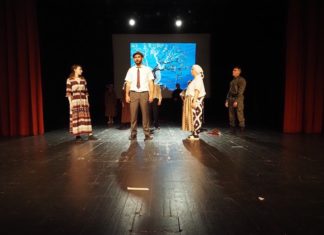The educational component that offers discussions on aspects of filmmaking and creates a debate on important issues that are faced not only by filmmakers but also by society itself, is also a feature of the AKE DIKHEA? Roma Film Festival. The digital availability of films and accompanying content facilitates cultural participation in terms of “culture for all” and at the same time creates a platform for active social and political reflection. In addition to workshops during the Festival which discussed the fact that despite the increasing number of films about the current situation of Roma in Europe, there is still a lack of perspective of the Roma themselves, two online events were organized in which Émilie Herbert Ponntonier, independent researcher and writer, brought perspective on the representation of Roma women in the film industry. Pointing out that they embodied an exotic ‘otherness’, Herbert Ponntonier states that they were often presented as victims of their community, and an escape from it was cited as an instant solution, all while accepting the help of a non-Roma man. Also, she underlined how Roma people, and especially Romani women, have inspired novels, operettas and theatre plays since the 16th century. The figures of the fortune teller, the seductress, or the thief have thus been present in popular culture for a very long time.
Roma and Sinti women had to wait until the 1980s to move from a position of a passive object of the cinematic gaze to becoming active producers of counter-narratives through the medium of film. 40 years is not such a long time to balance centuries of misrepresentations, states Herbert Ponntonier, and continues that even today, their contributions to the global film culture remain largely overlooked and their access to dominant, mainstream cultural industries is difficult and full of pitfalls. And while women mostly clean cinemas, the question is how many of them direct films or get roles in films? When film heroes tell the story of minorities or are themselves part of it, they are still subject to stereotypical portrayal, so film as one of the biggest entertainment industries must take on a greater role in raising awareness and acceptance of diversity. In these early films, Roma and Sinti female characters are indeed often hypersexualized, yet at the same time, portrayed as un-feminine. In the popular culture of the time, they came to be placed as the opposite of respectable white femininity, says Herbert-Pontonnier, and continues: The ideal Victorian woman was indeed pure, chaste, refined, and modest. Roma and Sinti women on screen, on the other hand, were often represented smoking, laying on the grass, speaking with their mouths full, spitting on the ground… Behaviors that were often emphasized to remind the audience of the assumed incompatibility of Roma people with the dominant society. As such, they embody the possible dissolution of dominant values. Cinema contributed to inscribing these ideas in people’s minds.
Women and minorities are far from proportionally represented when it comes to film roles, and getting screenwriting, directing and acting jobs is an important step in positioning oneself in Europe’s diverse film landscape. Faced with difficult access to production and promotion structures, women still manage to appropriate and reshape film language to articulate their own experiences. The films shown rely on stereotypes and prejudices present in society and the media, so one way to fight is to recognize such phenomena. Exactly as my interlocutor states Roma women don’t necessarily enjoy the same freedom of making a film about anything they’d like, rather than automatically carrying some sort of responsibility to speak for their community. That’s because they have to fight centuries of misrepresentations, but also because there are still so few Roma and Sinti women who are active in the film industry – and especially in more mainstream film circuits – and who get recognition, in terms of access to funding, to festival circuits, and to the possibility of telling the stories they want to tell. It’s the same issue for Romani actresses, who may not always have the power to refuse a part, or to negotiate a script, to give insights and opinions, and gain creative control over a film, she concludes.
However, the number of Roma filmmakers is growing, which was possible to see in the program of this year’s AKE DIKHEA? Roma Film Festival. In addition to their responsibilities, filmmakers also have the privilege of helping to shape an affirmative narrative in film art. Through advocacy and self-presentation activities, their stories influence the perception of the Roma community itself, but also others. The self-representation of Roma women through the medium of the film moves away from the traditional portrayal of a seductress, fortune teller, and witch, and in addition to presenting some older works such as the one about the story of Katarina Taikon, where the film seeks to perpetuate and give credit to certain women. There are also younger generation filmmakers that offer a voice to other groups, like Vera Lacková and Alma Dzafic Ferhatovic. Mihaela Drăgan and Simonida Selimovic together with Nina Kusturica on the topic of Witches and Roma Wonderwomen played with these motives by bringing a fresh female perspective, about the healing of intergenerational trauma through futuristic rituals and spells but about one that celebrates the protector of Roma, experiencing its own journey to her and from her, as well.











